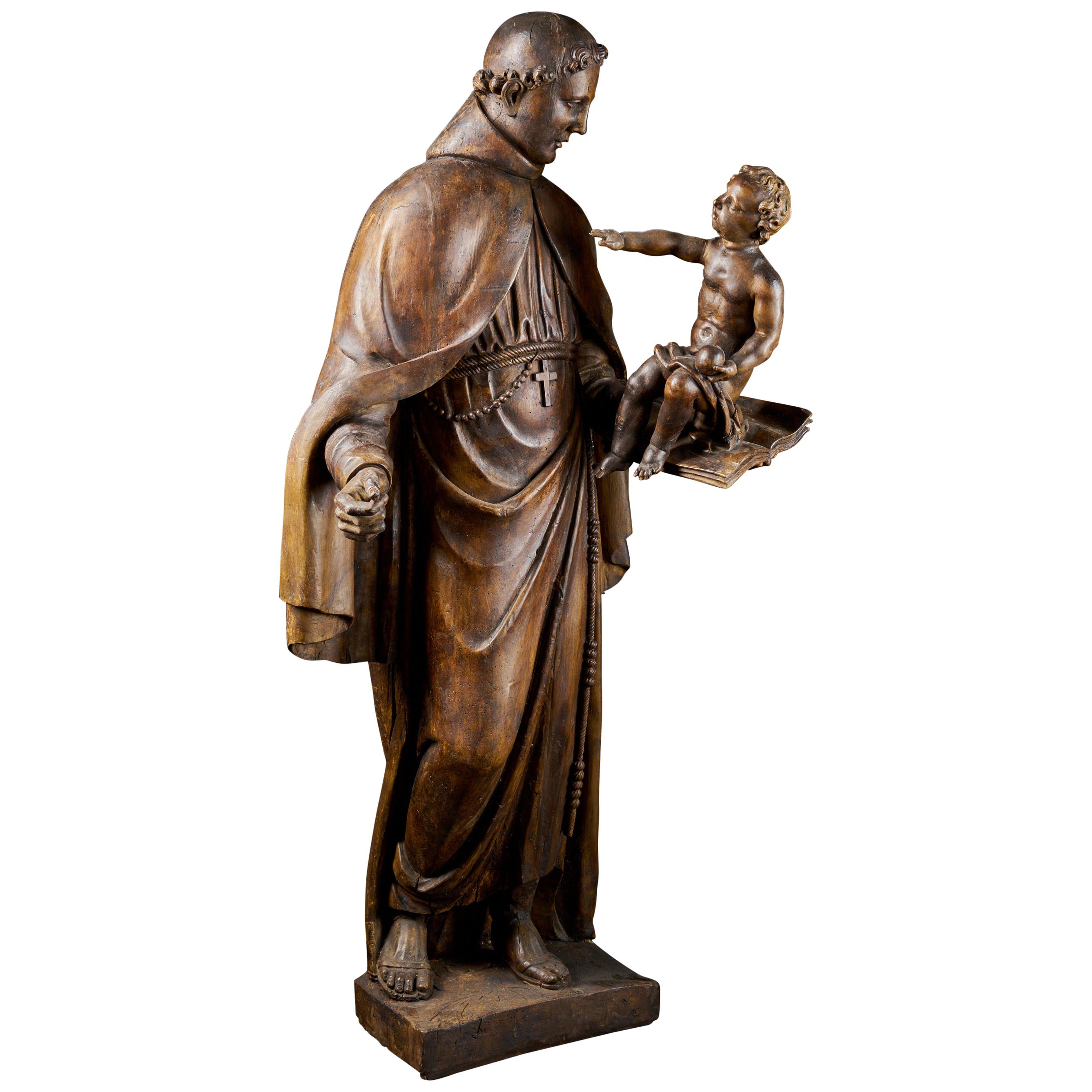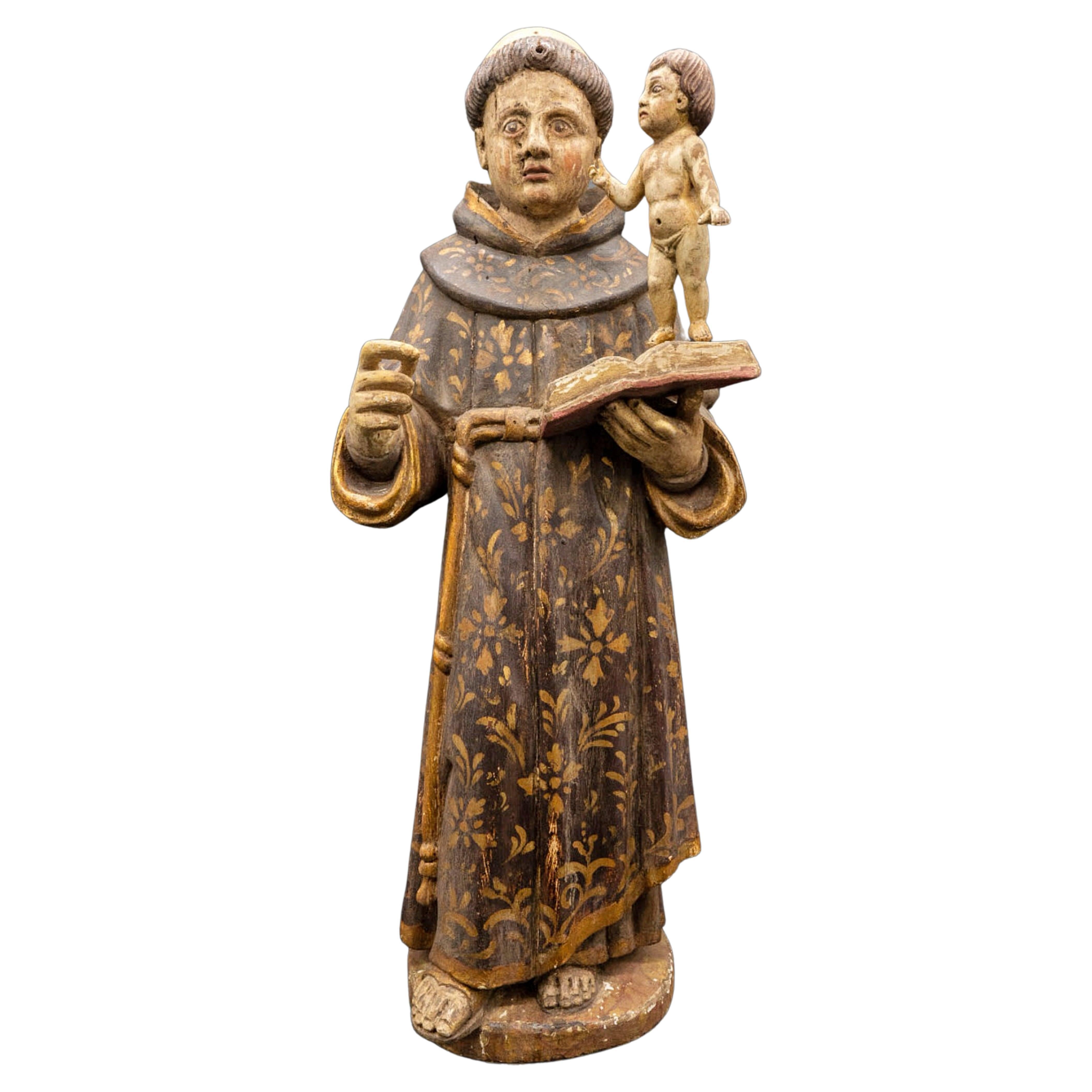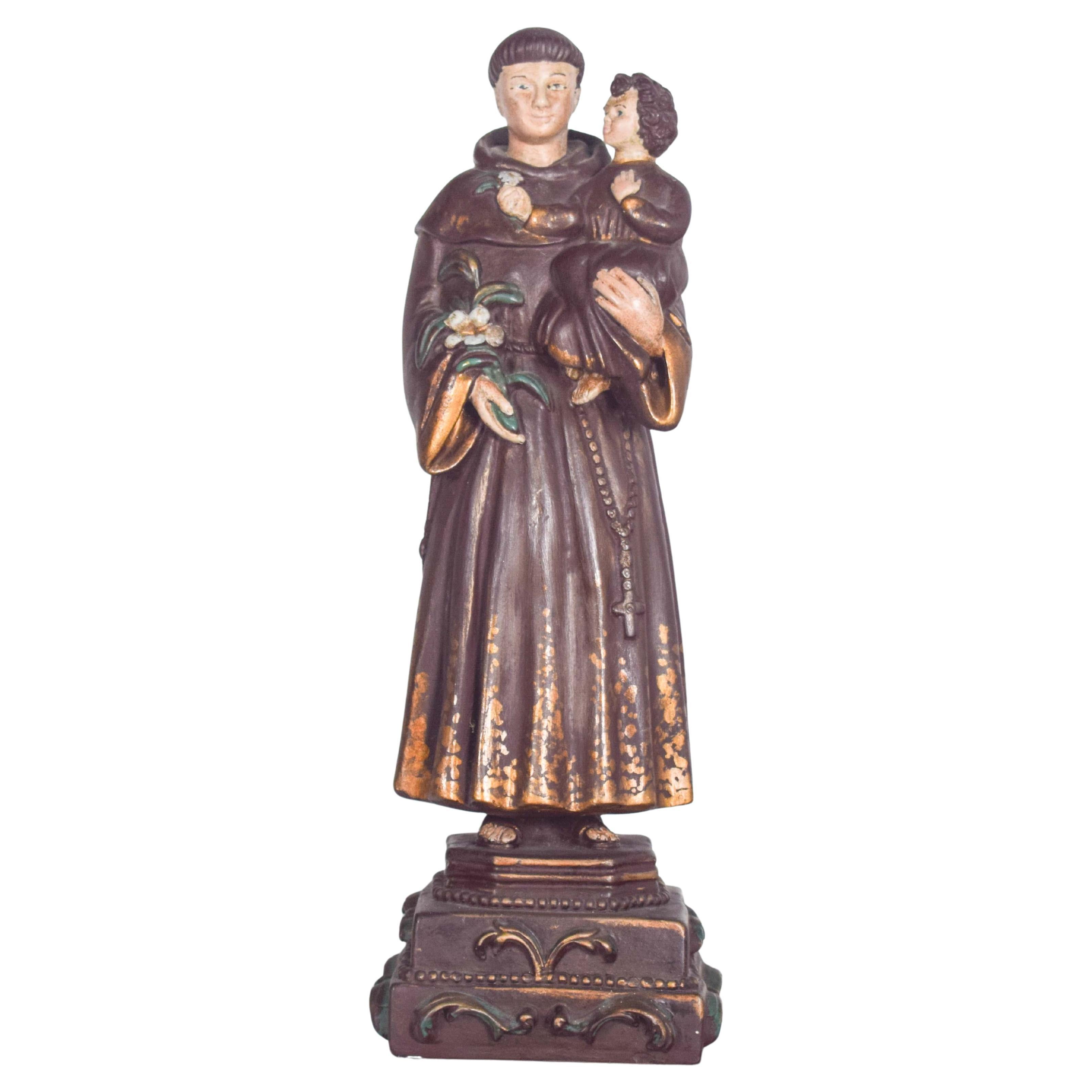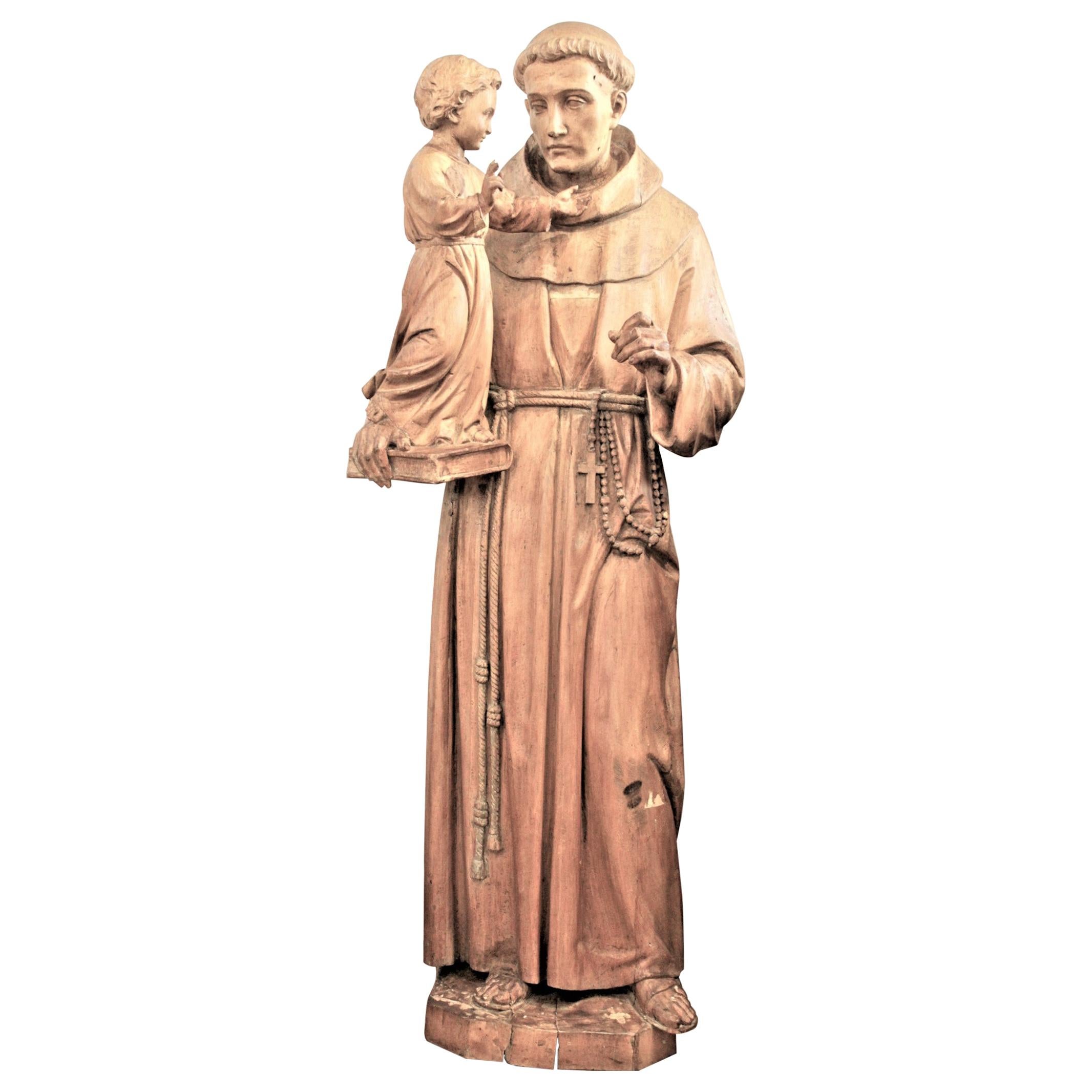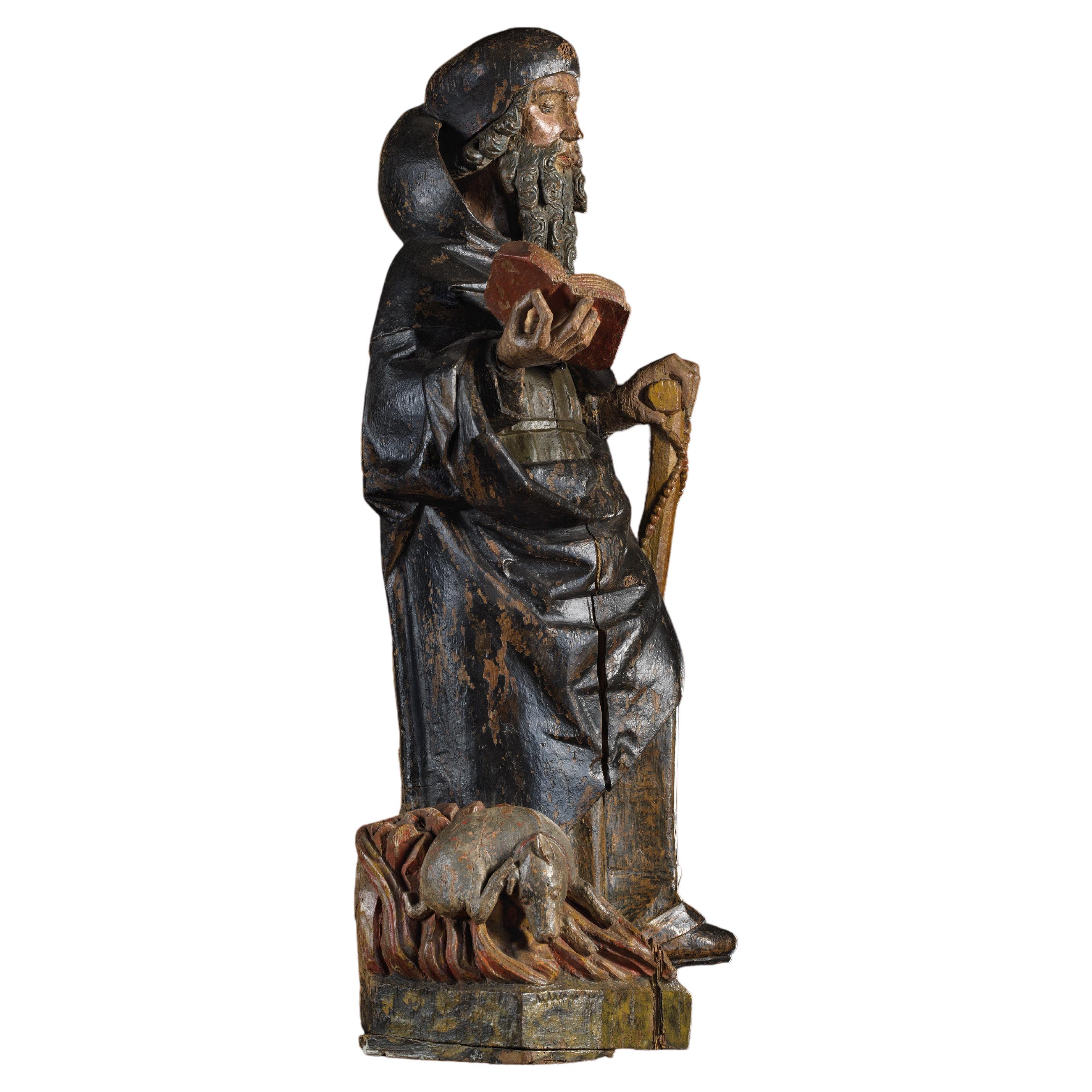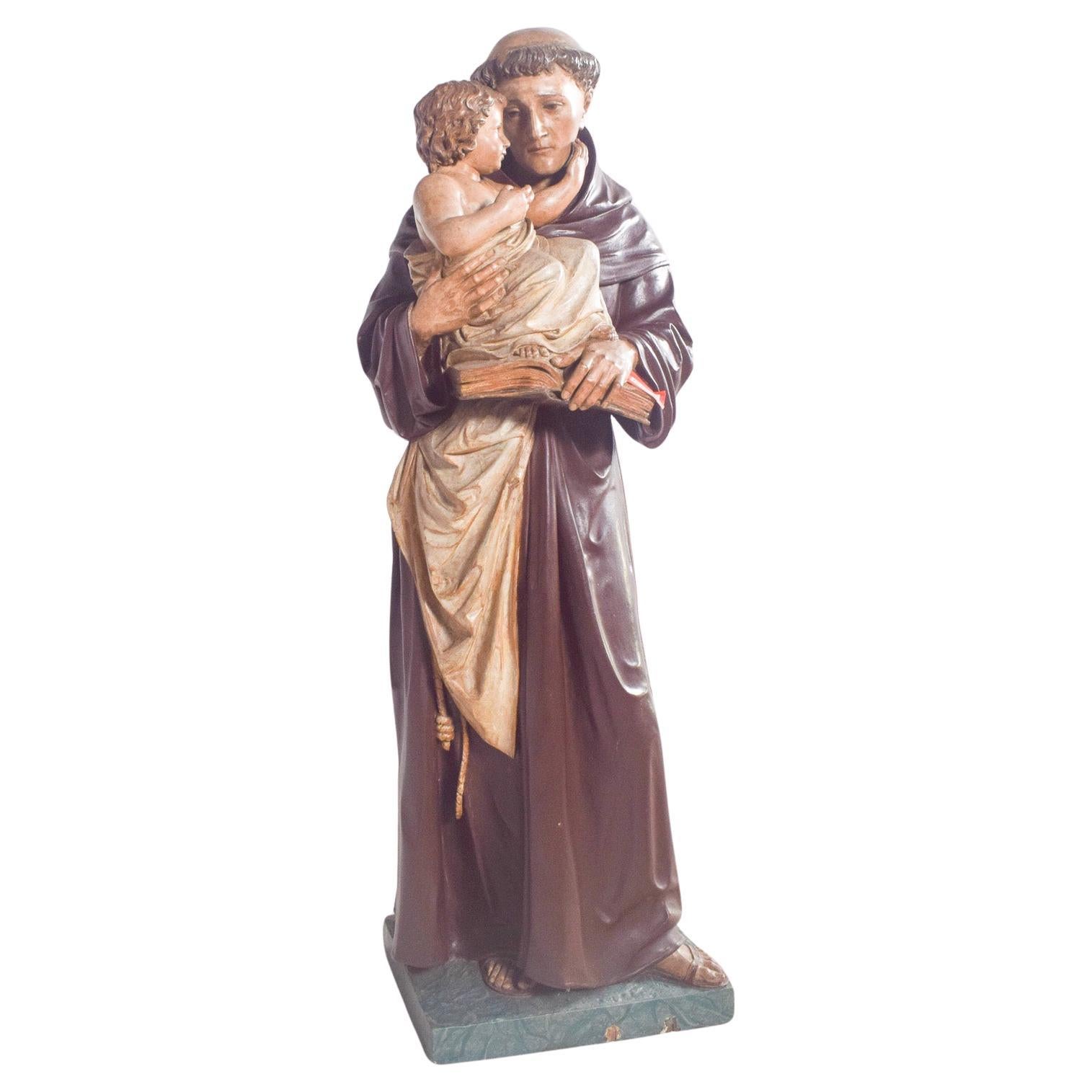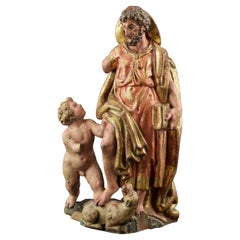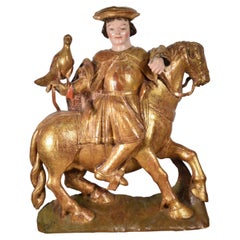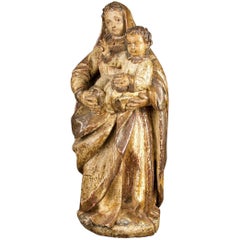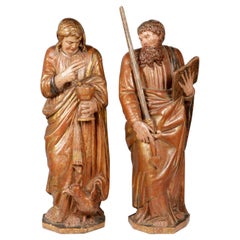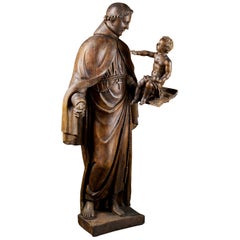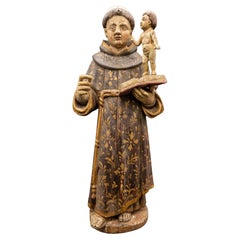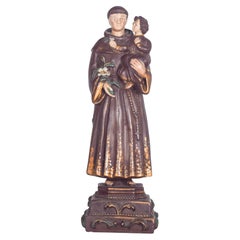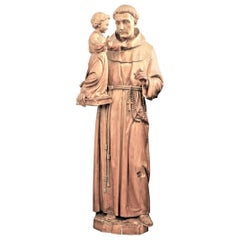Items Similar to Saint Anthony with the Child Jesus, Wood, Mechelen School, 16th Century
Want more images or videos?
Request additional images or videos from the seller
1 of 9
Saint Anthony with the Child Jesus, Wood, Mechelen School, 16th Century
$3,477.62
£2,587
€2,900
CA$4,762.05
A$5,294.75
CHF 2,764.63
MX$64,450.01
NOK 35,275.44
SEK 33,051.40
DKK 22,076.10
Shipping
Retrieving quote...The 1stDibs Promise:
Authenticity Guarantee,
Money-Back Guarantee,
24-Hour Cancellation
About the Item
Saint Anthony with the Child Jesus. Wood. Mechelen School, 16th century.
Sculpture in carved wood worked, as was usual in that center, on the front because it was designed to be placed on an altar, which represents Saint Anthony of Padua with the Child Jesus sitting on a book, in one of the most common iconographies for this Franciscan saint. The relationship with the Mechelen school is noted in the physiognomy of the figures, the remains of the polychromy, etc. The "poupées malinoises" or "Malines dolls" are small sculptures of saints made in the last years of the 15th century and the beginning of the 16th in the workshops of Mechelen (Flanders) and were known by these names due to the resemblance of their faces with that of the dolls or peponas ("poupins"); They were also sometimes called "chop sculptures" because they were finished only in their front part, being flat at the back, depending on the depth of the bottom of the niche where they were to be placed. They were executed for small domestic altarpieces -normally they contained three statuettes or "dolls"-, rectangular in the shape of the box and with painted wings or doors. The best known example is perhaps the altarpiece preserved in the Mayer van den Bergh Museum in Antwerp.
Size: 8,5 x 3, 5 x 28, 5 cm
International Buyers – Please Note: for those articles that need Export Permits (those older than 100 years), the obtaining of the Permit will be processed without additional expenses (if you choose the seller sends it to you), but the period for the obtention of it may vary from 10 to 35 days.
- Dimensions:Height: 11.23 in (28.5 cm)Width: 3.35 in (8.5 cm)Depth: 1.38 in (3.5 cm)
- Style:Renaissance (Of the Period)
- Materials and Techniques:
- Place of Origin:
- Period:
- Date of Manufacture:16th Century
- Condition:Wear consistent with age and use. Minor losses. Minor structural damages. Minor fading.
- Seller Location:Madrid, ES
- Reference Number:Seller: zf09071stDibs: LU2951328148832
About the Seller
4.9
Vetted Professional Seller
Every seller passes strict standards for authenticity and reliability
Established in 1985
1stDibs seller since 2017
346 sales on 1stDibs
Typical response time: 8 hours
- ShippingRetrieving quote...Shipping from: MADRID, Spain
- Return Policy
Authenticity Guarantee
In the unlikely event there’s an issue with an item’s authenticity, contact us within 1 year for a full refund. DetailsMoney-Back Guarantee
If your item is not as described, is damaged in transit, or does not arrive, contact us within 7 days for a full refund. Details24-Hour Cancellation
You have a 24-hour grace period in which to reconsider your purchase, with no questions asked.Vetted Professional Sellers
Our world-class sellers must adhere to strict standards for service and quality, maintaining the integrity of our listings.Price-Match Guarantee
If you find that a seller listed the same item for a lower price elsewhere, we’ll match it.Trusted Global Delivery
Our best-in-class carrier network provides specialized shipping options worldwide, including custom delivery.More From This Seller
View All“Saint Roch” Polychromed Wood, Juan de Anchieta’s Circle, Spain, 16th Century
Located in Madrid, ES
The bearded male figure appears with the angel, showing the wound or plague on his leg, with the hat and the pilgrim's cloak and the dog with the loaf of bread placed under one of his feet in a quite unusual way. All these attributes help to identify the image: Saint Roch (San Roque...
Category
Antique 16th Century Spanish Renaissance Religious Items
Materials
Wood
Possibly Saint Hubert or Saint Eustace, Wood, Spanish School, 16th Century
Located in Madrid, ES
Possibly Saint Hubertus or Saint Eustace. Carved, polychrome and gilded wood. Spanish school, 16th century.
Carving in polychrome and gilded wood, sim...
Category
Antique 16th Century Spanish Renaissance Religious Items
Materials
Wood
"Virgin with Child Jesus". Spain, End of the 17th-Early 18th Century
Located in Madrid, ES
Spanish Baroque sculpture is one of the most authentic and personal examples of our art, because its conception and its form of expression arose from the people and from the deepest ...
Category
Antique Late 17th Century Spanish Baroque Religious Items
Materials
Wood
Saints Apostles John and Paul, Wood, Castillian School, 16th Century
Located in Madrid, ES
Pair of polychrome wood sculptures. "San Juan and San Pablo". Castilian school, 16th century.
Both male figures have been represented standing, with their main iconographic attrib...
Category
Antique 16th Century Spanish Renaissance Religious Items
Materials
Other
"Saint Luke the Evangelist", Polychromed Wood, 16th Century
Located in Madrid, ES
Saint Luke is often represented as a man of mature and bearded age, accompanied by the animal of the Tetramorphs with which he is related (Revelation 4: 67)...
Category
Antique 16th Century Spanish Renaissance Religious Items
Materials
Wood
“Saint Dominic and Saint Francis”, Colonial School, 18th Century
Located in Madrid, ES
“Saint Dominic and Saint Francis”. Polychromed terracotta. Colonial (South America) school, 18th century.
It is narrated in this piece, with a remarkable...
Category
Antique 18th Century South American Baroque Religious Items
Materials
Terracotta
You May Also Like
Late 17th Century Italian School Wooden Sculpture of Saint Anthony and the Child
Located in Leuven , BE
According to the legends, there are two Saint Anthony’s, they can easily be distinguished by their hair. This one is known as Saint Anthony of Padua, he is recognizable by his hair, ...
Category
Antique Early 17th Century Italian Figurative Sculptures
Materials
Wood
Spanish Sculpture of the 17th Century "Saint Antony and the Child Jesus"
Located in Madrid, ES
Spanish Sculpture of the 17th century "Saint Antony and the Child Jesus"
Measures: H: 61cm,
polychrome and gilded wood.
Good condition.
Category
Antique 17th Century Spanish Baroque Figurative Sculptures
Materials
Wood
Sculpture of Saint Anthony With the Child, in Ceramic
Located in Lisboa, Lisboa
This ceramic sculpture of Saint Anthony with the Child is a beautifully crafted representation of devotion and purity. The figure stands tall, captured in a serene and gentle pose. S...
Category
Antique Late 19th Century Portuguese Rococo Figurative Sculptures
Materials
Ceramic
Large Antique Quebec Hand Carved Wooden Sculpture of St. Anthony & Jesus
Located in Hamilton, Ontario
This very large and well executed hand carved pine sculpture was done is unsigned, but believed to have been done in Quebec Canada in approximately 1850 in the period Early Victorian...
Category
Antique Mid-19th Century Canadian Victorian Figurative Sculptures
Materials
Pine
Sculpture in Polychrome Wood Representing Saint Anthony Hermit
Located in Saint-Ouen, FR
Sculpture In Polychrome Wood Representing Saint Anthony Hermit
Origin : East of France
Period : End of the 15th century
Measures: Height : 97 cm
Width : 32 cm
Depth : 26 cm
Polychrome wood
The saint is represented by an old, bearded man, dressed in a hooded monk’s habit over the tunic of his religious order. He is stood upright, holding an open book, La Règle des Antonnites, in his right hand. In the other hand, he is holding a staff in the form of the Greek letter tau with a rosary hanging down over it. At his feet lies a pig wearing a small bell around its neck.
He rests on his right leg, whilst the left advances forward as if he were about to start walking. His belted tunic, forming several rectilinear pleats, is covered by a habit which is open only at the waist, therefore revealing these pleats. He is also wearing a hooded scapular over his shoulders.
His thick hair escapes from under a distinctive hat, forming a collection of finely sculpted ringlets. This fine detail is also applied to the four long ringlets of his superb beard, which sit just below the shorter ones of his moustache.
His face is a picture of harmony, with lowered eyes and his small mouth lost amongst the abundance of hair.
At his feet on a pedestal of flames, hinting to the fire of Saint Anthony no doubt, a pig trying to scratch its ear.
Born in 251 in Upper Egypt, he withdrew into solitude at a very young age. He would have been plagued in the desert with extremely diabolical temptations.
He payed a visit to Saint Paul the hermit towards the end of his life. He was the dean of the Thébaïde anchorites, who was miraculously fed by a crow. On the day that Saint Anthony visited, the crow brought two portions of bread in its beak instead of one.
Some time after, having learnt of the death of his venerable brother, Saint Anthony went to bury him with the help of two lions.
The King of Catalonia pleaded to come and exorcise his posessed wife and children. He left Thébaïde for Barcelona. He appeared at the house of the provost André, bringing him a sow in his mouth, a monstrous piglet born without eyes. André wanted to kill it but Anthony stopped him, telling him that the poor beast wanted to ask for healing, as the King had done for his offspring.
He made a sign of the cross on the piglet and it suddenly acquired its sight and the members which it did not have at birth. After which, André, guided by Saint Anthony, exorcised the Queen of Catalonia in the same way whilst she knelt at his feet.
Théophile discovered the body of Saint Anthony wrapped in a palm fibre tunic which he had been given by Saint Paul the Hermit.
In the Red Sea Desert there are two Coptic, IV century, monasteries which stand next to each other, one dedicated to Saint Anthony, the other to Saint Paul the Hermit. They are the oldest monasteries in the Christian world.
The body of the famous hermit was transported to Constantinople and would have been transferred into the abbaye, Saint Antoine-en-Viennois, Dauphine.
The Antonnite Order was a charitable order which specialised in treating contagious diseases. The fire of Saint Anthony, was identified by doctors as a grangrenous ergotism, caused by a diet of rye bread contaminated with the parasite ergot. The effect of this is the drying out of hands and feet which then need amputation, the plague and then later syphilis. All the skin diseases came from Saint Anthony.
Saint Anthony’s pilgrimage to Dauphine rivaled that of Saint Jacques to Compostela. Thanks to the various commanderies created by the mother house, Saint Anthony’s cult spread throughout Christianity.
In order to maintain commanderies and their hospitals, the Antonnites resorted to pig farming. They enjoyed having the benefit of letting their pigs roam freely through the streets of the villages, with little bells round their necks that had a recognisable chime so that they were able to find them. This privilege was very envied by other monastic Orders.
Saint Anthony was the patron saint of several crafts such as basket makers and gravediggers.
However it is to the pig that he owes the majority of his patronages; pigkeepers, pig sellers, butchers, porc butchers, brush makers who use pig bristle and bell-ringers because of the pig bells...
Category
Antique 15th Century and Earlier Figurative Sculptures
Materials
Wood
Saint Anthony with the Child Ceramic Sculpture
Located in Lisboa, Lisboa
Saint Anthony with the Child, ceramic sculpture. Saint Anthony wears the traditional brown Franciscan habit, with the characteristic three-knotted cord around his waist. The Baby Jes...
Category
Antique Late 19th Century Portuguese Rococo Figurative Sculptures
Materials
Pottery
More Ways To Browse
Antique Carved Wood Religious Sculpture
Religious Saint Sculpture
Antique Wood Niche
Carved Wood Jesus
Religious Niche
Altar Box
Niche Altar
Saint Anthony And The Child
Antique Three Face Doll
Religious Plaques
Carved Wood Religious Figure
Antique Sacred Heart
Jewish Menorah
Hanukkah Menorah
Carved Wood Jesus
Silver Menorah
Antique Orthodox
Mexican 18th Century Furniture
